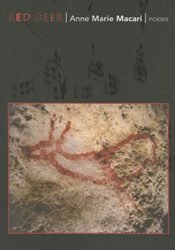
Anne Marie Macari’s fourth collection of poems, Red Deer, is a stumbling backwards into the prehistoric caves once inhabited by our ancestors, into this dark space that tunnels itself through the earth. Inspired and transformed by her travels to view cave art in France and Spain, Macari shares with us her journey toward the darkness as she explores the empty spaces beneath the earth, and the empty spaces within each of us.
The underworld of Red Deer is one that hovers between fluidity and stillness. Paintings of animals long extinct have been preserved in the mineral stillness, but the caves are not quiet sanctuaries. In “Going Under,” the speaker lumbers deep into the world underground “…passed mineral flowers and slick pillars growing / drop by sticky drop—the life of darkness / mushrooming, foaming underground.” The speaker finds herself torn between turning back toward the illuminated surface or delving further, entranced by the intelligence of the dark.
Macari prompts us to think about how to approach the relics left behind by our predecessors, both human and animal: the ochre paintings of a falling horse or a mammoth in the snow, the ribcage of a bear, a city of bones beneath St. Peter’s Basilica. In “All Souls,” the speaker ponders a cave painting of a wild goat, wondering,
…Will it always
be buried? Memory
stumbling into mineral stillness,
crystallized, almost lucid, or carried—
a forgotten animal across
my shoulders…
Will we allow ourselves to become detached from our ancestors who put charcoaled fingertip to stone in a world so vastly different from our current reality? Not Macari. Her poems unearth for us a darkness brimming with wisdom.
The speaker’s exploration of the past is portrayed as a transformative type of healing. In “Bison,” it becomes clear that the paintings preserved in the darkness consist of far more than ochre and stone,
To become the rock, and then
the bison of the rock, hunched where
the stone hunches, there to cure myself,
unhook the human worm.
Each image serves as a doorway to the wisdom of the past, and we are left to question the myths we’ve created for ourselves, to consider the fragility of our beliefs, and come to terms with the disposability of our bodies. The speakers portrayed in Red Deer do not subscribe to the limitations of the physical body, but instead try on the coats of bison, deer, and mammoth. In “Red Deer,” the speaker remarks,
Once I was an animal, like you, red deer,
bright as arterial blood, with
sure feet. The painter pressed you
to life with pointer and thumb.
 Macari is a painter in her own right, bringing images to life. She takes us below earth and beyond it, to the realms of dream world and memory, and each experience is as rich and real as the last.
Macari is a painter in her own right, bringing images to life. She takes us below earth and beyond it, to the realms of dream world and memory, and each experience is as rich and real as the last.
She examines the body. In “Neanderthal Flute,” the speaker admits, “I never thought of myself / as separate from my skin, without / whorled fingertips, without lips,” and this statement feels like a confession. It becomes clear that the body, neglected, becomes wasted space, as portrayed in “Missing,”
…Darling, don’t ask
me to sleep beside your coffin, side
by side up there on Mt. Hope—why
take up room?
Our bodies will decay and transform in much the way a tree can become a lake. Bodies are disposable, but this isn’t to say they aren’t useful. It took ancient hands to create the cave art we are still admiring today.
Behind every cave image is a painter whose life was far different from our own. Behind the art, the hands that created it. This artwork is what we have left to connect our light-drenched lives above ground with those of a darker, wiser past. In “Since There Are Pockets,” we are reminded of the importance of these artifacts,
…we placed
our hands just so on the walls
of space so you would know
we were here
Our ancestors put their pigmented hands to stone and created art that inspires the wisdom we see in this collection. Red Deer asks us to consider the history, much our own history, buried deep in the memory of stone. What would it mean for us to look past our myths? What would it mean to take this book into your hands?




